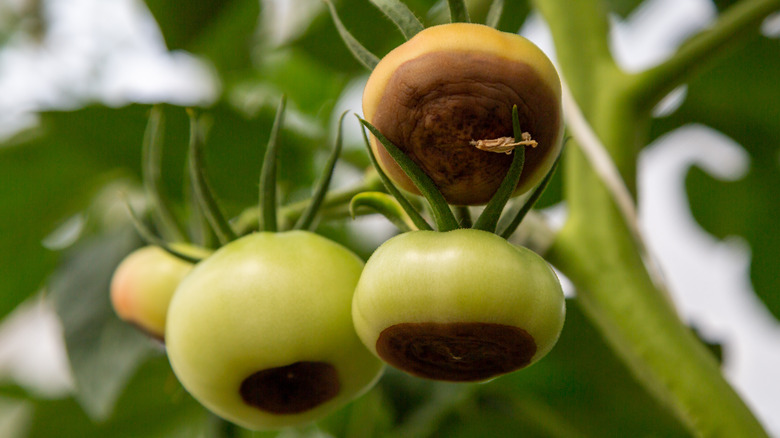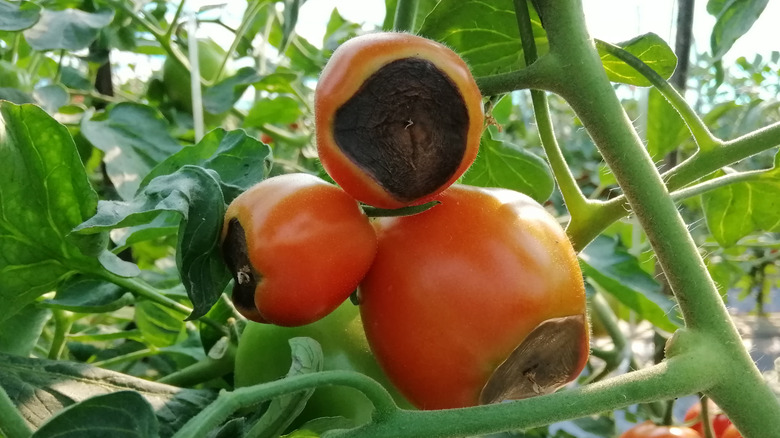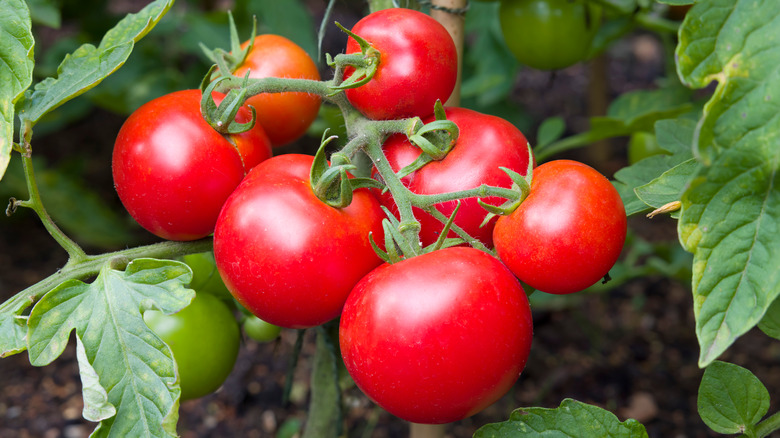Why The Bottoms Of Your Tomatoes Are Turning Brown And How To Prevent It
Tomatoes that look like they're decomposing from the inside out suffer from an all-too-common (and always annoying) problem called blossom-end rot. A small, water-logged spot at the bottom of your unsuspecting tomato characterizes this grotesque affliction. The blemish grows until your fruit hangs leathery, shriveled, and lifeless. While blossom-end rot will not spread from tomato to tomato, it strikes without warning and can be blamed mainly on environmental factors and a lack of proper nutrients. Yet another reason why it's important to pay close attention to what's going on with your food-producing family.
While there are more than a few reasons why your tomato plants have contracted the unsightly disease, keep in mind that you hold some sway when protecting your fruitful bounty. So if you find that some of your tomatoes are suffering from blossom-end rot, just remember that it's impossible to control Mother Nature, so you're going to need to learn to work alongside her instead.
What's the root of the issue?
A few different factors come into play when it comes to those unsightly blemishes on your tomatoes. But they all have one thing in common — insufficient calcium. This is one of the most critical elements for proper tomato growth because it plays a substantial role in the fruit's cellular structure. When developing tomatoes don't have access to enough calcium, the cells become weak and can't hold their shape. This causes the tissues to break down, starting at the bottom.
The first culprit, and possibly the most obvious, is inconsistent watering. This causes the moisture level of the soil to fluctuate, which can reduce its calcium content. Extreme fluctuations in temperature and humidity also play a significant role because they leach water, disrupting the plant's ability to absorb calcium and transport it through cellular structures. Another offender is unbalanced soil, particularly substrate with a high pH or too much nitrogen. Both can negatively affect the tomato plant's ability to take up calcium and water, resulting in a sad tomato with a rotting bottom.
You have the power to stop the rot
If you happen to notice that a few fruits on your tomato plant are looking a bit soggy-bottomed, never fear. The quickest and easiest way to prevent blossom-end rot is first to remove any blemished fruits and affected leaves. If you happen to compost or need a reason to, save discarded eggshells and add them to the soil. This boosts the calcium level, though it can take months for the microbes in the substrate to completely break down the shells. So this isn't an instantaneous fix. If you notice that the two-gallon pack of milk is about to expire, don't fret. Your tomato plants might find some use for it. Theoretically, a concoction of diluted milk applied directly to the leaves is said to help with calcium uptake. While too much milk can stunt the plant's growth, a little bit goes a long way.
When it comes to caring for tomato plants, remember to follow the middle way. Don't over or underwater, remember to add mulch, and don't forget to fertilize when needed. And if it's still an issue, just remember that blossom-end rot generally goes away on its own.


